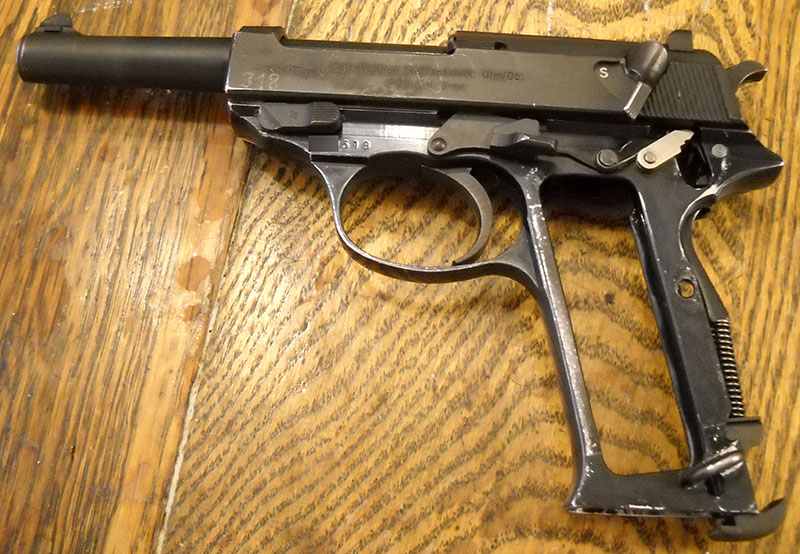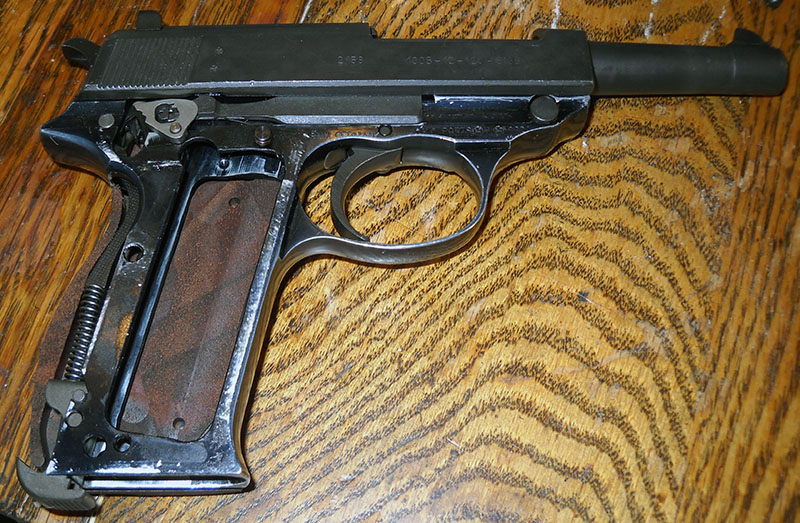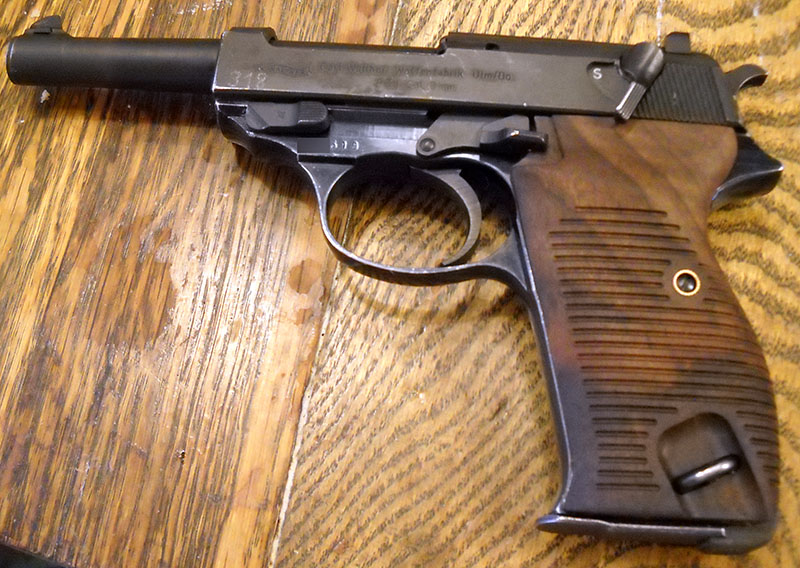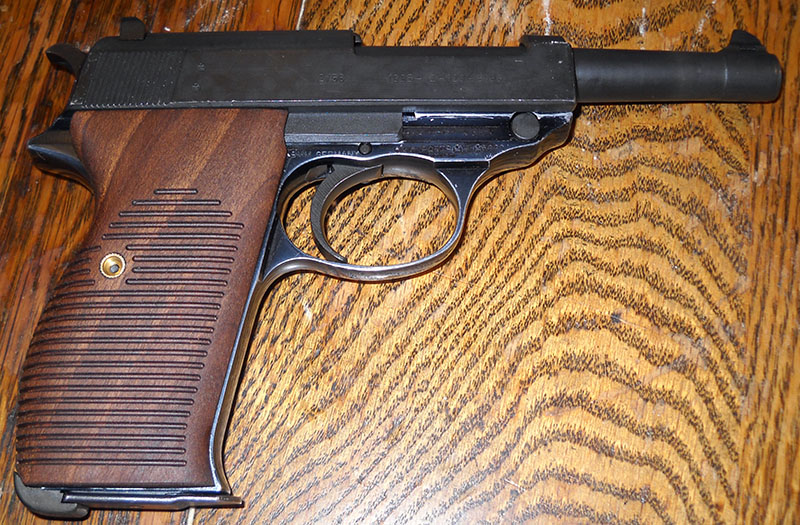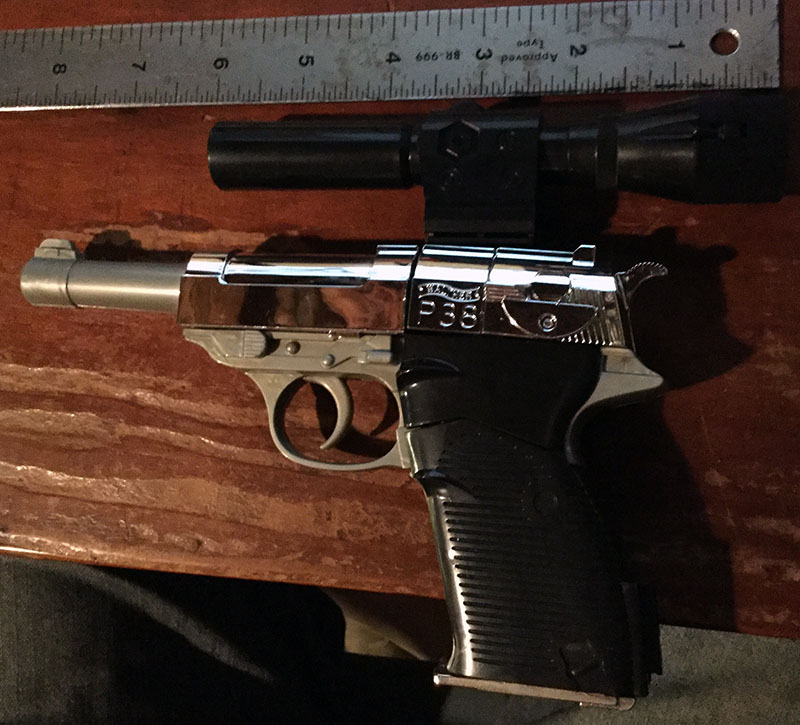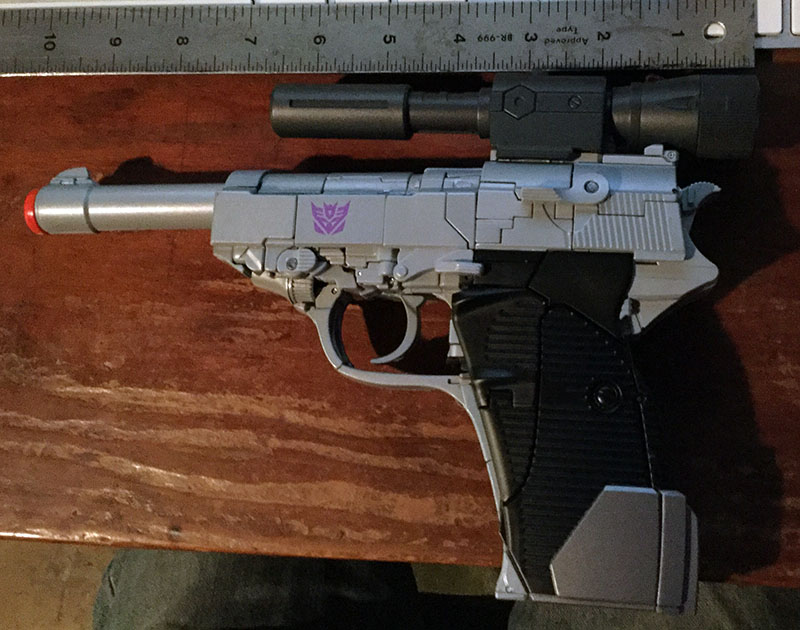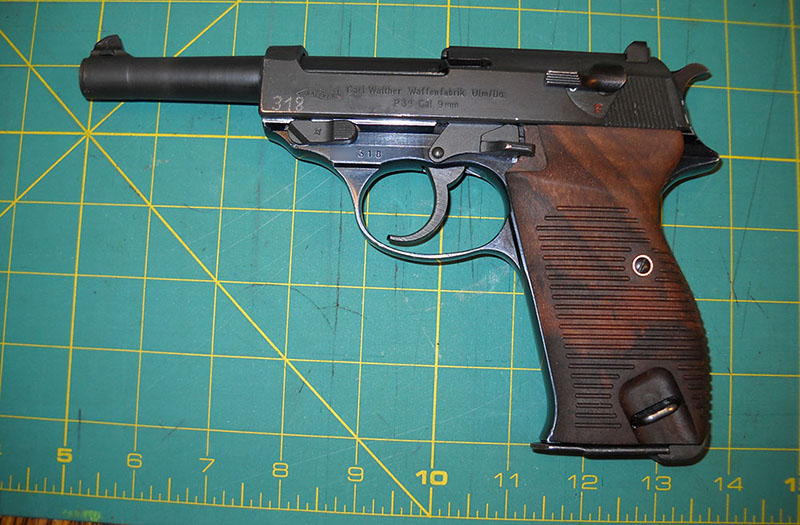LAST EDITED ON Apr-22-17 AT 02:12 AM (EDT)
To inaugurate the new GotW board and celebrate the end of a long-ass week at work, I decided to jump the gun* and post this entry a little early. Enjoy!--G.
* get it? jump... 'cause it's early... I'll be in the car.
It's 1956, and Fritz Walther has a problem.
His problem is that, 11 years after the end of World War II, West Germany is just being allowed to have an army again. Having been forced to surrender all its arms at the end of the war, that army will have to be re-equipped from scratch. The company that lands the contract to provide the new Bundeswehr's weapons stands to make very, very money, and the smart bet is on the pistol that was the old Wehrmacht's choice just before the war—Walther's P38.
The P38 had been developed in the mid-'30s to replace the Parabellum P08, popularly known as the Luger, which was a well-regarded pistol but very complicated and expensive, difficult to maintain, and known to be temperamental in poor conditions. Walther's design (said to be principally the work of Fritz Walther himself) was none of those things. It was simple, it was robust, it required much less complex manufacturing, and it was so easy to disassemble for maintenance that it's possible to seem like you did it accidentally. So many were required by the wartime Wehrmacht that the Walther company itself only made about half of the total production; the others were made under license by Mauser and another company called Spreewerk.
Unfortunately for the Bundeswehr, virtually all those 1.2 million or so wartime P38s were gathered up by the Allies as part of Germany's disarmament, and either taken away as reparations or destroyed; so here in 1956, the new Bundeswehr will have to find a source of completely new production if it intends to standardize on the same design. Which, on its face, sounds like Herr Walther has the opposite of a problem! He has it on good authority that his pistol is still the military brass's choice, and since all the old ones are gone, he'll have to make all new ones. For which he will get paid! A lot! And make no mistake, Fritz Walther likes to get paid. So how is any of that a problem?
Well, it's a problem because the factory where the originals were made was in Zella-Mehlis, Thuringia. Which is now part of East Germany. It was handed over to the Red Army in '46, looted, and burned to the ground. Spreewerk's pistol plant, in Czechosolvakia, fared no better, and Mauser's factory was gutted by the French Army. Since Fritz's escape to Ulm, in the west, at war's end, his company has consisted essentially of a stack of patents. All of the technical drawings, all of the tooling, and most of the expertise with which the original P38s were manufactured: gone. Either destroyed or carried away by the Russians and/or the French.¹
As such, what Walther and his reconstituted company's designers had to do basically amounted to reverse-engineering their own product, from the patent drawings and the few intact samples of pre-war production that could be scrounged up in the country. This they proceeded to do, and here is an early example of the fruits of their (repeated) labor.
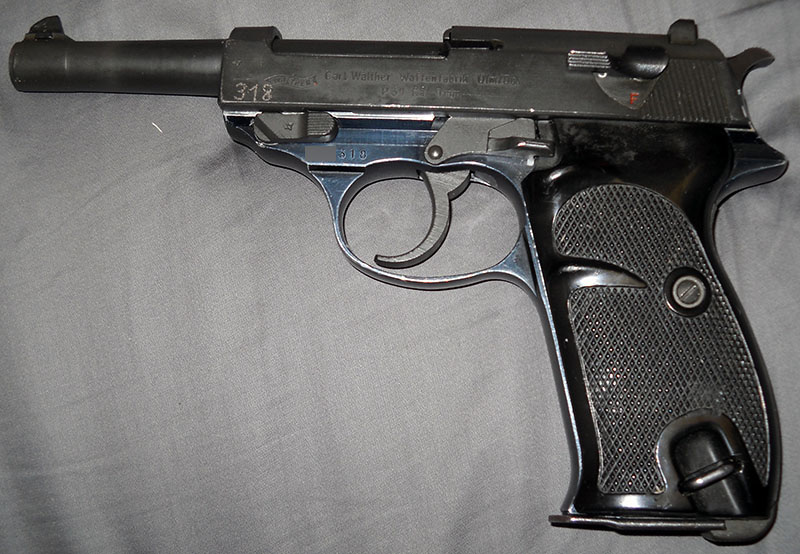
This version of the P38 entered serial production in 1957. This particular one is from February 1958. How do I know that? Did I look up the serial number in a lengthy database online somewhere, or flip through a dusty reference tome moldering unnoticed in some academic library somewhere, or write a letter to the company inquiring as to its production history, as are the usual ways of finding out things of that sort?
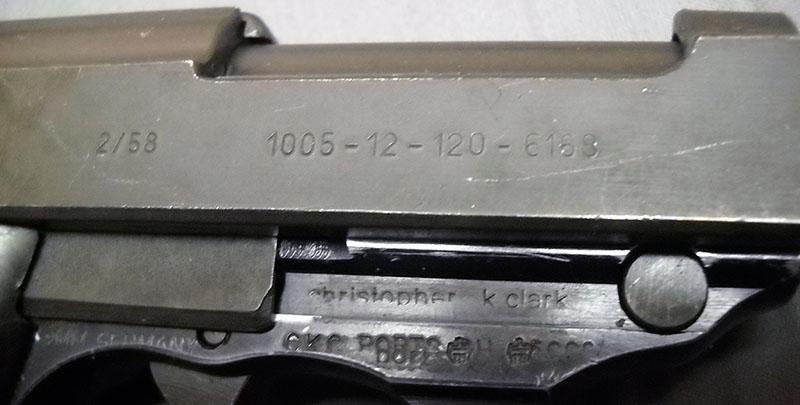
Well, no, they wrote it right on the gun. Thanks, Germany!
(That long number next to it is the original Bundeswehr stock code, which probably means something about the pistol's original disposition within the organization, but I'm dipped if I know what.)
Also visible in this shot are the federally mandated import marks, which are an excellent example of how not to do that kind of thing. Not only are they haphazardly applied and semi-legible (you tell me where this particular importer was headquartered, for example), Mr. Clark chose to apply them over top of the acceptance/proof markings on the frame. Pas de points, sir.
Over on the left side, things are a little saner.
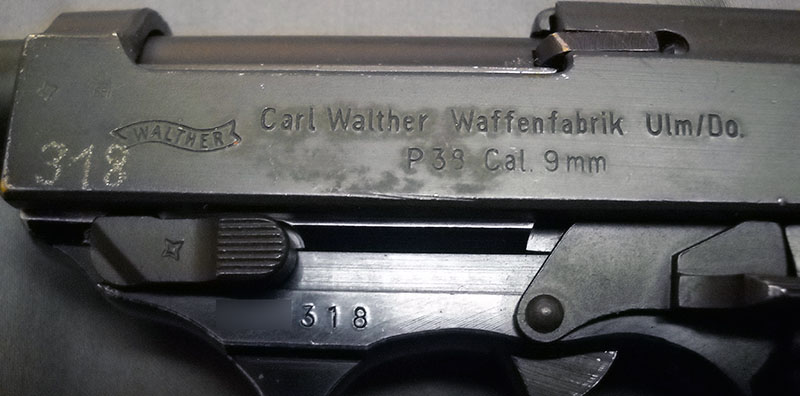
Someone did feel the need to electropencil the last three digits of the serial number on the slide, but I don't know whether that was the importer, the Bundeswehr, or someone else altogether. Some German manufacturers, such as Mauser, used to have the fretful habit of stamping the serial number on absolutely any part that was large enough to have numbers stamped on it, but evidently Walther either didn't go in for that, or had stopped doing it by 1958.
At any rate, the markings over here are pretty straightforward, but there's a lot of information packed away in them. You have the famous Walther banner logo, the name of the company and where it was,² the model name, and what caliber it's in.
Very faintly visible above the electropenciled "318" are a couple of armorer's stamps. These indicate that the pistol received a modification necessitated by a technical change notice (in this case, a slightly redesigned firing pin) and that it passed post-modification inspection, respectively. The disassembly lever (on the left) also has a star stamp, indicating it was replaced with a stronger redesigned version at some point.
Oddly, there is no Bundeswehr proof/acceptance stamp next to the serial number, which is where I'm told they usually are on these early second-generation guns. I cannot account for this. On the other hand, there are four on the righthand side, two on the frame and two (very faint) on the slide.
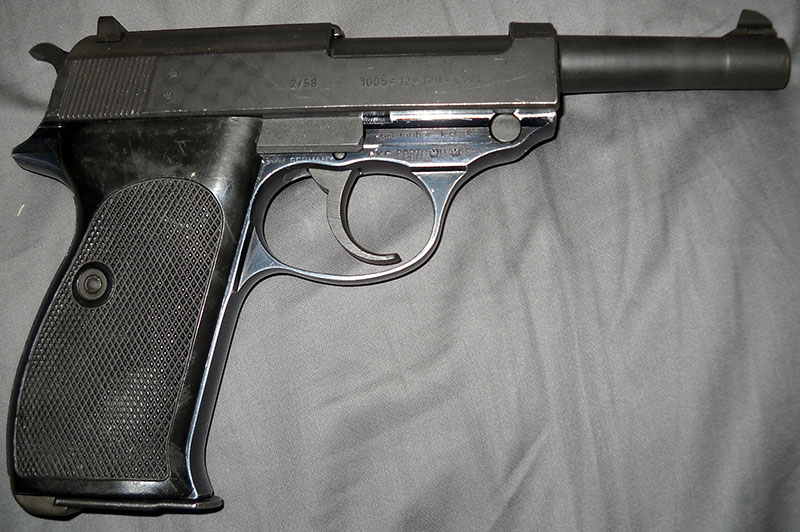
Mechanically, the postwar P38 was identical to its wartime predecessor. It uses a short-recoil system, but instead of a tilting or turning barrel locking mechanism, the P38 used a sort of "falling block" arrangement. The barrel is locked to the slide by a pivoting block underneath; as this block travels within the frame, it hits an obstruction that tips it down after the assembly has come just far enough back for the bullet to clear the muzzle. This releases the barrel to stop while the slide carries on backward without it, cycling the action. As the slide returns to battery, it pushes the barrel forward, which tilts the block back up again and locks the whole affair back in place for the next shot.
At the time, this was pretty innovative. Fritz Walther and his team had been struggling to come up with a new locked-breech system, so that they could build a pistol chambering 9mm Parabellum, for some time before the P38 first appeared on the scene. (The company's first 9mm was an attempt at a blowback system made safe by inertia and spring tension, which pretty much never works out and didn't for them either.) The advantage the Walther system offers over Browning's is that although the barrel isn't fixed, it only moves along its bore axis, which theoretically makes for a more accurate firearm. It's also a little easier to manufacture, because you don't need a swinging or angled link or locking lugs inside the slide. In fact, the barrel doesn't need to be inside the slide at all, and indeed most of the P38's isn't.
If any of that seems strangely familiar to you, but you're not a German military armorer, you might be an American one, because if you take apart a Beretta Model 92—one version of which is the US GI M9—you'll find exactly the same system, which is how the Beretta can get away with having that open-topped slide. No need for any Browning-style locking lugs up there if you're using the Walther locking block system instead.
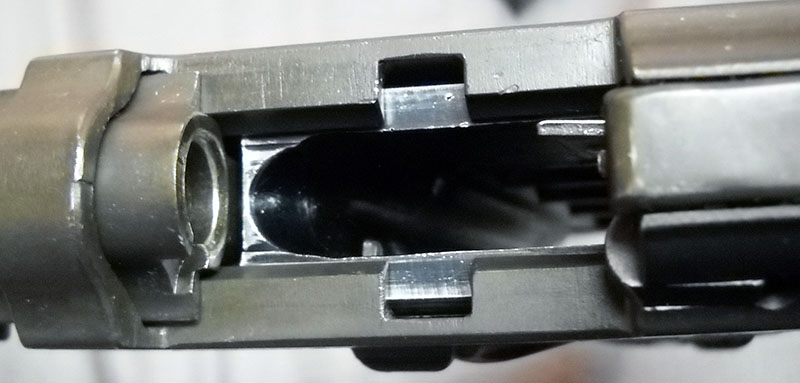
Here's a view from the top, looking down into the open action. Notice that the P38 has its extractor on the left and ejector on the right, which makes it eject the spent brass off to the left—rather unusual, most autos either eject out of the right or, if they're open on top like that, straight up.
Other features of the P38 that were unusual when it first appeared include its double/single-action trigger; it wasn't the first semiauto pistol to have such a trigger system (Walther's own PP predated it by a few years), but it was still a recent enough innovation that the novelty hadn't worn off. Also like the PP, it has a safety that doubles as a decocker, dropping the hammer without setting off the chambered cartridge.
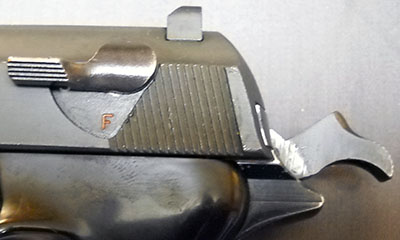
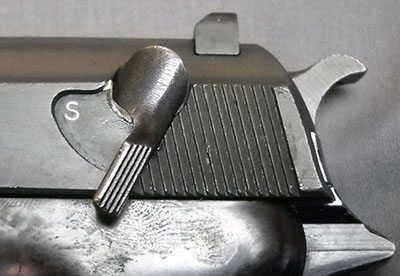
This is a feature that you see a lot on DA/SA autos nowadays, but which was still pretty new and fresh in 1938.
One less innovative feature of the P38 was the heel release on its eight-round, single-stack magazine.
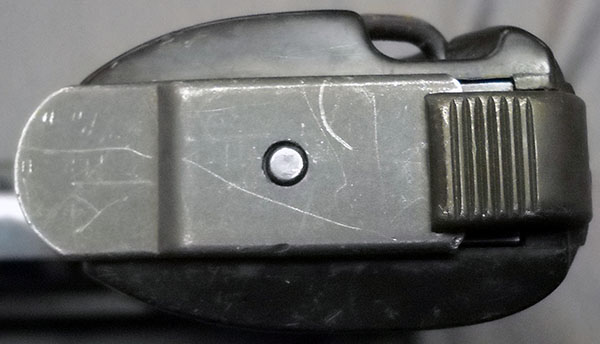
This was a common feature of semiauto pistols, particularly European ones, up until mid-century. A bit unexpectedly, the Luger this pistol replaced had what we would now perceive as a more modern button release (as did the PP, oddly enough), but the P38's heel release wouldn't have seemed in any way odd or awkward to its intended users, and unlike many such releases the Walther's is very smooth and easy to use.
Speaking of which: I said earlier that the P38 is absurdly easy to disassemble for cleaning. I wasn't kidding, check this out. Here's what you have to do.
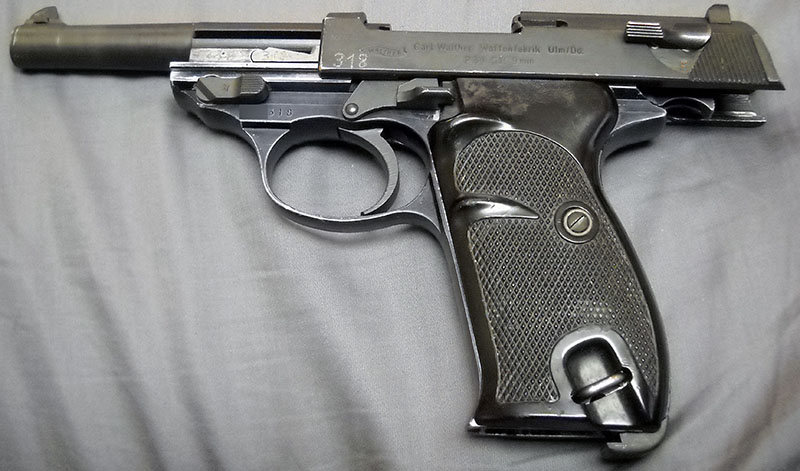
1) Lock the slide open. This will happen automatically if you open it on an empty magazine; or, if you've taken the magazine out already, you can lock it manually by opening it and pushing up the slide release (the lever above and just behind the trigger). Either way, if you've done it right, the pistol will be empty and the magazine removed at the end of this step.
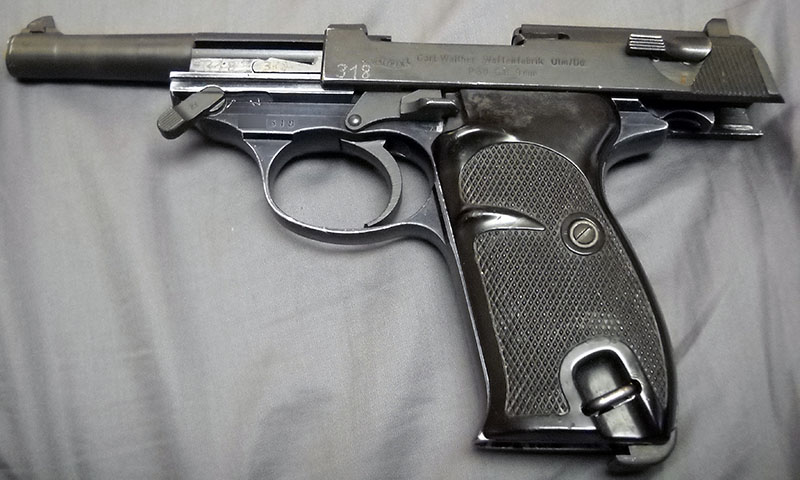
2) Flip the takedown lever forward. This lever looks very like the one on the Luger, but is approximately 100,000 times easier to use. It requires no tool.
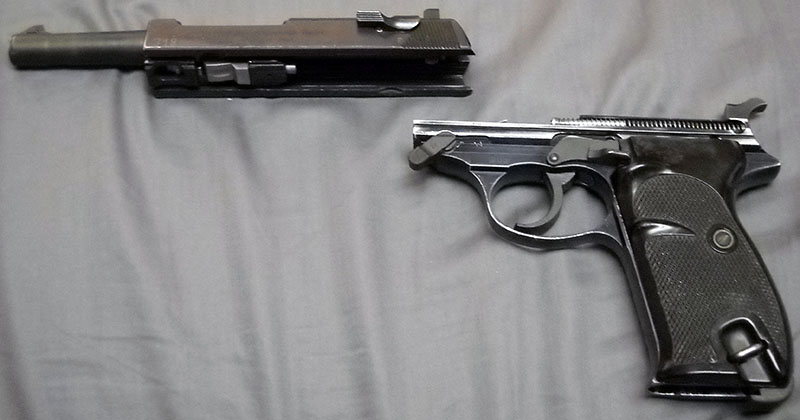
3) Take the slide forward and off. You'll have to let the hammer down, one the slide is back in battery, before it will come forward off the frame. You can do this with the old finger-on-trigger, thumb-on-hammer technique, or use the decocker safety. In the latter case, it's still a good idea to ease the hammer down, to save wear and tear on the machinery.
4) Remove the barrel. To do this, turn the slide-barrel assembly over. Notice that the barrel locking wedge (the silver part) is in the up or locked position.

See the silver plunger at the back (right) of the assembly? That's what hits the surface inside the frame to disengage the lock.
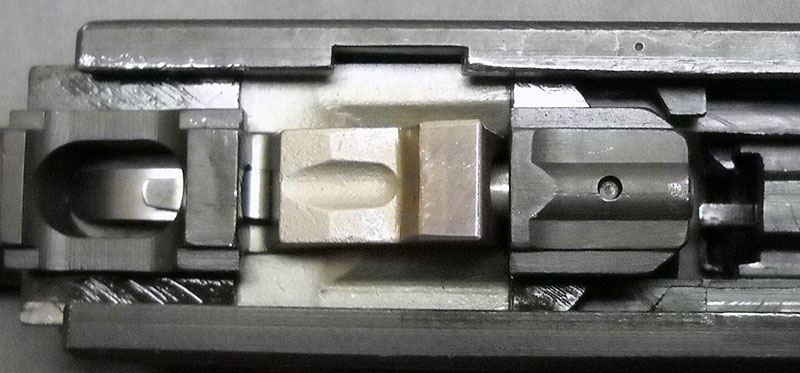
If you press it now, it pops the locking block down (or, well, up, since you're holding the slide upside down) and unlocks the barrel...
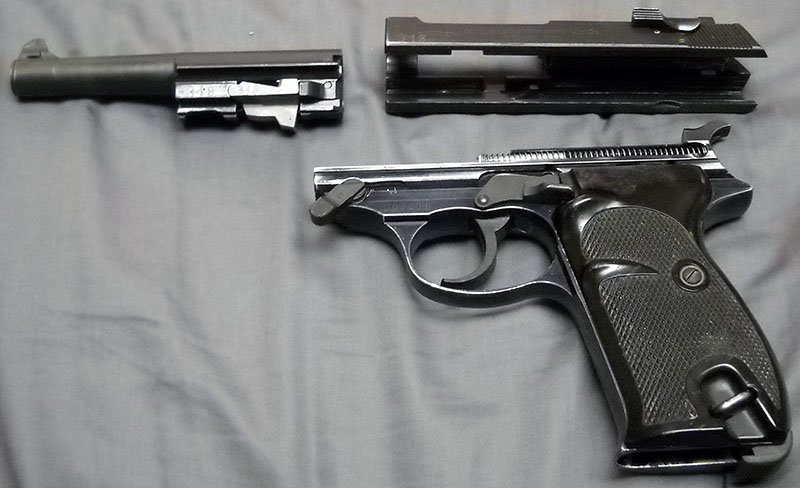
... and the barrel/lock assembly comes right out of the frame.
That's it! You're done. Your P38 is now dismantled and ready to be cleaned and maintained.
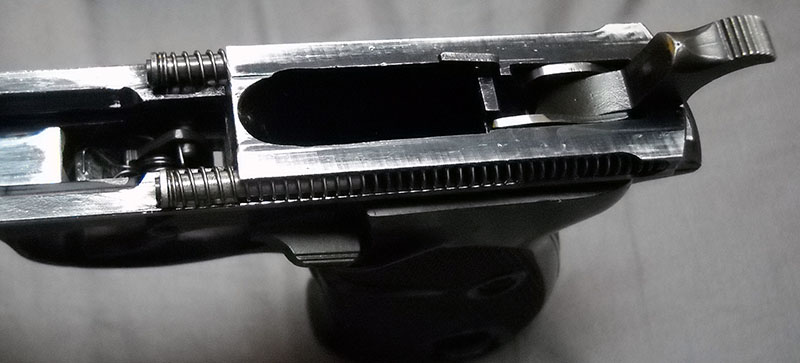
With the slide off the frame, you can see another of the nice features of the P38's design: the captive recoil springs, one on each side.
Reassembly is the opposite of disassembly, with a couple of minor caveats and only one fairly major one. To reassemble the barrel and slide, you must make sure the barrel's locking block is down in order to put them together, then push it up so that the assembly will go onto the frame as one piece. It will unlock again when it reaches the point in reassembly where that should happen, but you don't want them coming apart before then.
The major caveat, and really the only significant "gotcha" I could find in the P38's design, is when you get to here:
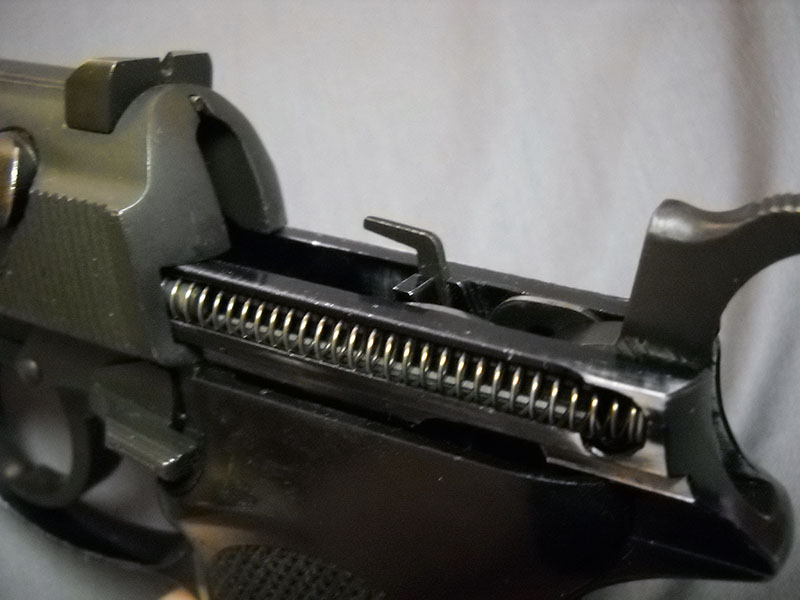
That hook-shaped thing sticking up there is the ejector, and if you just ram the slide backward onto it, you'll break it. You have to carefully tuck it down and ease the slide back over it (it's spring-loaded, so it'll pop back up if you're not careful). It's the only step in the whole process where there is a real possibility of breaking something. Once you've got the slide back on there, you can rack it all the way back, secure it with the slide lock, then flip the disassembly lever back around and you're good to go.
One difference between the original 1930s/early 1940s P38s and the ones built starting in 1956 was that Walther adopted a design change that had originally been a wartime expediency in late-production war P38s and made it standard on the new ones. Because of Germany's crippling steel shortages late in the war, P38s made in the last few months had frames made from anodized aluminum alloy rather than steel. That seemed to work pretty well, and was even cheaper to produce, so the postwar production used that technique from the very start.
The alloy frame on the Bundeswehr P38s wasn't completely trouble-free; some of the earliest ones started going out of service with cracks around the area where the barrel lock impacts the frame. Investigation determined that this was because 1950s 9mm Parabellum ammunition was considerably hotter than its wartime equivalent, producing pressures and operating forces that the aluminum components weren't designed to endure. (The fact that the affected pistols were usually the ones used for marksmanship drills, in which soldiers used pistols kept specifically for the purpose rather than their own issue weapons—and thus, those range pistols were getting a lot more use than all the others in the inventory—surely contributed.) Walther updated the design several times over the next 20 or so years, reinforcing both the vital bits of the frame and the parts of the slide and barrel assembly that took the most punishment.
On paper, the second-generation P38's service life was quite short, only seven years. In 1963, it was retired and replaced with the P1, so designated because it was the Bundeswehr's first pistol. The P1 was also supplied by Walther, and here is a complete list of the differences between them:
1) The P1 says P1 on it, not P38.
2) There is no second thing.
Seriously, that's it. The 1958 pistol shown here, officially, was a P1 after 1963; the ones made before that date weren't removed from service. Only the designation got changed, and the ones produced after the change were marked accordingly. Oh, Germany. :)
The P38/P1 would go on to spawn two more generations of 9mm Walther military pistols, the P4 (a more extensively reinforced model that looks like a P38 that's been taking its vitamins) and the P5 (a streamlined, mildly redesigned version that, at a glance, looks like a P38 without a barrel). There were also small-production specialty variants like the P38k (k for kurz, German for "short"), which was basically a P38 with just a stub of a barrel, and the so-rare-as-to-be-possibly-mythical P38SD, which was, supposedly, integrally suppressed.
P1s remained in service with the Bundeswehr through 2004, when they were finally finished being phased out and replaced with the Heckler & Koch-made P8 (known to the civilian market as the USP). I believe some police agencies may still use them. Civilian P1 production ended in 2000.
Apart from appearing in war movies and pretty much any film featuring the German police from 1960 through about 1990, the P38 never really made the impression on popular culture that its predecessor had. Despite being an innovative and reliable service arm, it doesn't have the Luger's distinctive silhouette or dramatic connotations. In fact, it seems a little boring by today's values, simply because so many of its features have been imitated to the point where they've become more or less standard.
One place the P38 did appear in pop culture was the 1960s TV spy series The Man from U.N.C.L.E.—although it was sort of the firearms equivalent of an actor in that, since the gun it "played" wasn't supposed to be a Walther at all. It was the basis for the elaborate prop "U.N.C.L.E. Special" guns wielded by the show's protagonists. Or at least it was after the original Mauser Model 1934-based prop gun kept failing to work and was deemed too small to photograph well.
Thanks to a strange connection from the U.N.C.L.E. version, Transformers fans will recognize the P38 as the original alternate mode for Decepticon Commander Megatron. This is probably its most famous fictional incarnation, though even that was more coincidence than anything else: the fanciest Microchange toy happened to be the Man from U.N.C.L.E. special edition of the transforming P38 toy, so it was the natural choice for the G1 Decepticon halo character, but that means it wasn't a deliberate character design choice. Anyway, Megatron almost immediately ceased to be a P38 after Transformers Generation 1, because realistic-looking toy guns³ ceased to be a Thing in the American toy market shortly thereafter, which is why whenever Megatron appears nowadays he's a tank or a mobile space cannon or some similar thing.
--G.
-><-
Benjamin D. Hutchins, Co-Founder, Editor-in-Chief, & Forum Mod
Eyrie Productions, Unlimited http://www.eyrie-productions.com/
zgryphon at that email service Google has
Ceterum censeo Carthaginem esse delendam.
¹ If all of that sounds like harsh karma for Herr Walther, it might help to keep in mind that he was, to be generous, a war profiteer. As one of the regime's favorite arms designers, Fritz was involved in some deeply questionable business during the war. The Walther company made use of slave labor at the SS concentration camp near Neuengamme to manufacture weapons for the Wehrmacht; it has also been alleged, though documentary evidence seems to be lacking, that Fritz was also managing the Gustloff works for the government at a time when they were making rifles at Buchenwald.Be that as it may, he was never charged with any war crimes; his rescue from the Soviets by American troops seems to have been arranged as a sort of firearms-designer equivalent of Operation Paperclip, the "let's get the rocket scientists" job. Still, one could argue that he had earned, at the least, some hard times.
² Carl Walther was Fritz's father, the company's founder, who died in 1915. "Ulm/Do." is short for "Ulm an der Donau", that is, Ulm-on-the-(River-)Danube—an older-fashioned way of writing Ulm's name, in the same way that some English cities have names like Newcastle-upon-Tyne or Weston-super-Mare.
³ For values of "realistic-looking" that include being significantly smaller than the real thing, but don't go by me. A G1 Megatron toy that is actually the correct size in gun mode would be pretty awesome. Maybe the Masterpiece version is? I've never seen one.

 Printer-friendly copy
Printer-friendly copy





















